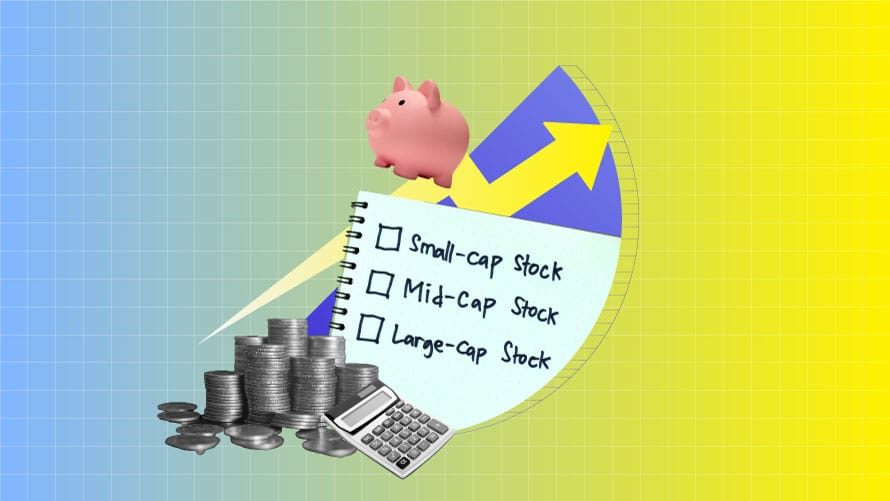SIP Calculator
×Understanding the difference between large cap, mid cap, and small cap funds

For people who are new to the stock market, it is important to know the difference between small cap, mid cap, and large cap stocks. In terms of growth potential and risk, they are not the same. Likewise, mutual funds that invest in these stock categories vary in their portfolio composition and return potential. Small-caps have room to grow, mid-caps are a good mix of safety and growth, and large-caps are reliable, long-standing companies. Continue reading to learn more about these stocks and how to invest wisely.
People who want to invest in the stock market need to know enough about it to pick stocks that will work best for their investment plan. There is risk in the stock market and the risk varies from stock to stock.
Understanding market capitalization
One of the best ways to figure out how much a company is worth is to look at its market capitalization. Readers need to know that a company’s net worth is the market value of its shares. This is calculated by multiplying the total number of shares outstanding with the price of each share. However, it also means that this method can only be used to judge publicly traded companies.
Buyers need to understand what market value means because it helps them pick the right shares to buy. For this type of review, changes in the market and stock prices impact how a company is judged. When buyers make a long-term business plan, they need to know how much a company is worth.
Knowing the value and risk of a company helps an investor create a balanced investment spread across stocks from various companies. When looking at companies based on their small cap, mid cap, and large cap status, investors should know that this reflects how developed a company is in its business journey. Investors need to consider the current stage of a company’s development when assessing it from an investment portfolio.
Large-cap companies
Companies with a market value of over ₹20,000 crores are called large-cap firms. They are the most stable and well-known names in the Indian stock market. On this list, you’ll find big names such as TCS, Reliance, and Infosys. Large companies are known for being stable and reliable.
However, given their sheer size, growth for large-cap companies will be slow. But there is only a slim chance that the business will fail. You can choose to invest your money in a large-cap mutual fund or directly into large-cap stocks. If you choose the second option, you can add some variety and enjoy a faster growth rate. Huge and medium-sized funds, for instance, put their money into big and medium-sized companies’ stocks. This way, you can get the safety of large-cap stocks.
“Start investing with confidence! Explore the best mutual funds and grow your wealth.”
Mid-cap companies
Medium-sized company stocks make up at least 65% of the investments made by mid-cap mutual funds, which are open-ended equity mutual funds. The 101st to 250th most valuable companies (by market cap) on the stock market are called mid-cap stocks. Mid-cap companies can become large-cap companies. They have a good track record. But there are also chances of things going wrong. These funds try to find a good mix between risk and gain. Because they invest in companies that are still growing, these funds may have more room to grow than large-cap market cap funds.
They are very sensitive to changes in the market, but they are also safer than small-cap market cap funds. To protect themselves from these changes in the market, investors are often advised to keep their money in these funds for a long time. This will help buyers keep their money safe even during market fluctuations.
Small-cap companies
When it comes to market value, small-cap companies usually have less than ₹5,000 crores in market cap. These businesses can grow quickly, sometimes even at an exponential rate. They are innovative firms that can give clients very high returns. But small-cap stocks are also the riskiest. If business gets tough for small-cap companies, many of them may go out of business.
That being said, if you can find good small-cap companies, they can fetch you good returns. It’s easy to put money into small-cap stocks through small-cap funds. Quite often, buyers add small-cap market cap companies to their portfolios to enjoy faster growth.
Differences between large-, mid-, and small-cap funds
Large-cap funds tend to be more predictable than mid-cap market cap and small-cap funds, but they also have less room to grow. When a business is small, it often has more room to grow, but it also takes on more risk. Here are some noteworthy differences between small caps, mid-caps, and large caps:
- Levels of market capitalization
The value of all of a company’s outstanding shares of stock is called its market valuation or market capitalization. To calculate it, multiply the current market price of a share by the number of shares outstanding. Market value limits are not set in stone and can be different depending on the meaning, but they are used as a guide for categorizing companies into groups.
- Levels of risk and volatility
Small-cap funds are more risky and volatile than mid-cap and large-cap funds. Small caps are more likely to be affected by changes in the market and business challenges. Large caps, on the other hand, tend to be more stable, but have less room to grow. Midcaps are somewhere in the middle. They often have the flexibility to grow, but their business plans are more stable than that of small caps.
- The chance of growth and the return on investment
Small caps often have a lot of growth potential as they are still in the early stages of growth. You can also grow with mid-caps, but there is lesser risk than with a small-cap market cap. Large caps tend to offer steady returns that aren’t as high, and their dividend payments are often a big draw.
Small-cap, mid-cap, and large-cap stock investment strategies
Now that you know the difference between small-cap, mid-cap, and large-cap stocks, you should know that buyers can use a wide range of strategies when they look at small-cap, mid-cap, and large-cap stocks. These strategies are made for investors with a range of investment styles and risk tolerance so that they can align their strategy with their financial goals.
- Investing in value
Value buying is a technique that has been around for a long time and works for all market capitalizations. Value buying in small-cap stocks means looking for companies that are selling below what they’re really worth. This is usually because the market is negative or the company has had a loss.
Investors who use this approach look for opportunities to buy stocks that aren’t worth as much as they’re worth, hoping that the market will finally figure out what the stocks are really worth. Value buyers also look for companies in the mid-cap market cap and large-cap groups that have strong prospects and sound finances that deserve a close look.
- Mix your investments
Blend investing, which is also called “core and satellite” investing, takes aspects of both value investing and growth investing and puts them together. Using this approach, you keep a core portfolio of various large-cap companies for safety and allocate some of your portfolio to small- and mid-cap stocks for growth potential.
The goal is to find a good mix between safety and chances, with bigger risks and higher rewards. Investors try to get the best of both value and growth tactics while keeping the general risk of their portfolios low.
- Investing for growth
Growth trading is all about finding companies that are about to grow a lot and making the most of their potential for fast growth. Growth buyers in small-cap stocks look for new companies in niche markets that have the potential to shake up industries. Mid-cap stocks are those of companies that have a history of steady progress.
Growth buyers look for companies that can keep their above-average growth rates going, even in large-cap market cap stocks. When you use this approach, you are willing to take on more risk in exchange for the potential of making big gains.
Conclusion
Understanding small cap, mid cap, and large cap funds can help you spread out your investments in different ways. If your large caps aren’t doing so well, your mid and small caps might be faring better. In the event that your mid or small caps are doing poorly, your large caps might be doing better, keeping your general returns steady.
So, people who invest in stocks and mutual funds should spread out their money by buying stocks with different market caps. It will help your stock get through times when the market is fluctuating. Before buying, people should think about their financial goals, how much risk they are willing to take, and how long they want to keep the money. It takes close study and analysis to invest in the stock market or mutual funds.




